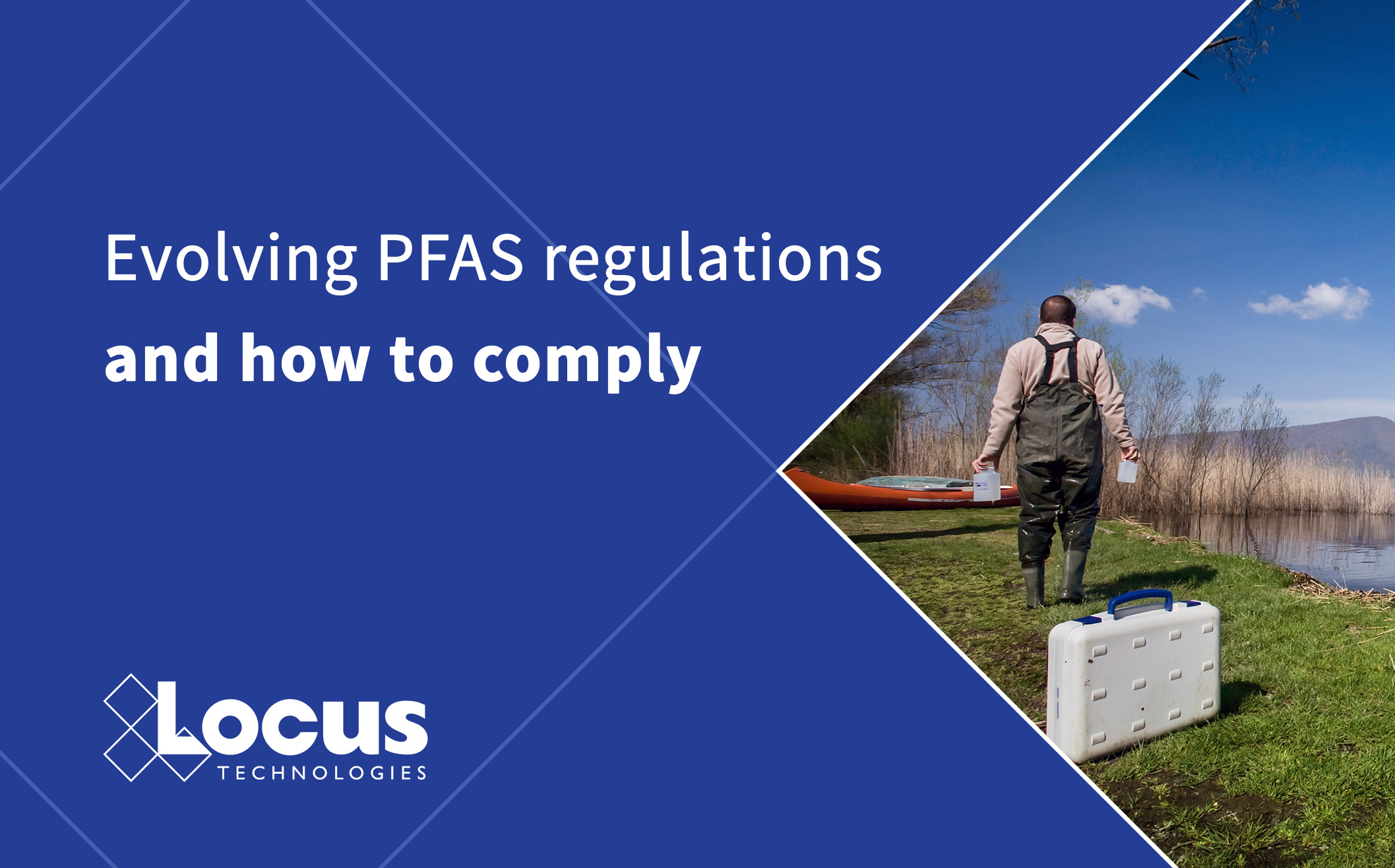
Locus Technologies is at the forefront of PFAS management solutions in the United States, leveraging decades of experience and expertise on this critical subject. Our advanced EIM SaaS platform houses the largest centralized PFAS database, enabling organizations to manage and analyze their PFAS data with unparalleled efficiency and accuracy. By staying ahead of the US EPA’s evolving PFAS regulations, Locus provides trusted digital compliance solutions, helping organizations navigate these complex challenges seamlessly. With our industry-leading tools and commitment to innovation, Locus is your partner for tackling the future of PFAS compliance.
Introduction
The U.S. Environmental Protection Agency (EPA) is taking progressive measures to regulate per- and polyfluoroalkyl substances (PFAS) in the environment using a “whole-of-agency approach”(1) to address risks to human health, including cancer, and ecological risks. PFAS are a class of chemical substances used in various products, including cookware, food packaging, water- grease- and stain-repellants, firefighting foams, and other products. PFAS are found in all environmental media (air, water, soil) and drinking water.
EPA has developed a PFAS roadmap with “…Three Overarching Goals…
- RESTRICT – Pursuing a comprehensive approach to proactively prevent PFAS from entering air, land, and water at levels that can adversely impact human health and the environment.
- REMEDIATE – Broadening and accelerating the cleanup of PFAS contamination to protect human health and ecological systems.
- RESEARCH – Investing in research, development, and innovation to increase understanding of PFAS methods, human health and environmental risks, and technologies.”(2)
Key EPA actions taken to address human and environmental impacts from PFAS
Clean Water Act (CWA) – In 2024, “EPA issued the first-ever national, legally enforceable drinking water standard to protect communities from exposure to harmful PFAS.”(3) EPA issued maximum contaminant levels for 6 PFAS compounds to reduce exposure to over 100,000,000 people served by public drinking water systems.(4)
Additionally, EPA has proposed “Final Recommended Freshwater Aquatic Life Ambient Water Quality Criteria and Acute Saltwater Aquatic Life Benchmarks for Perfluorooctanoic Acid (PFOA)” and “Final Recommended Freshwater Aquatic Life Ambient Water Quality Criteria and Acute Saltwater Aquatic Life Benchmarks for Perfluorooctane Sulfonate (PFOS),” according to the Clean Water Act (CWA)”(5) which states and tribes may consider when adopting new water quality standards.
Manage sample data, schedules, tasks, and reporting for drinking water, stormwater, or wastewater in Locus Technologies integrated cloud-based platform.
Comprehensive Environmental Response, Compensation, and Liability Act (CERCLA) – “According to the Comprehensive Environmental Response, Compensation, and Liability Act (“CERCLA“ or “Superfund“), the Environmental Protection Agency (EPA) is designating two per- and polyfluoroalkyl substances (PFAS)—perfluorooctanoic acid (PFOA) and perfluorooctanesulfonic acid (PFOS), including their salts and structural isomers—as hazardous substances.“(6) CERCLA authorizes notification, emergency and spill response, enforcement, and cost recovery actions for contaminated sites and during chemical transportation under U.S. DOT Hazardous Materials Regulations (HMR).
Manifest Reportable Quantities in the Locus Platform Waste Management application and report spills and environmental releases in the Incident Management module.
Destruction and Disposal – In 2024, EPA issued its “Interim Guidance on the Destruction and Disposal of Perfluoroalkyl and Polyfluoroalkyl Substances and Materials Containing Perfluoroalkyl and Polyfluoroalkyl Substances— Version 2 (2024)” “…as required by the National Defense Authorization Act (NDAA) of 2020…” which “…directs EPA to address the destruction and disposal of PFAS and specific PFAS-containing materials…”.(7) This guideline establishes science-based methodologies for safely disposing of “…aqueous film-forming foam, contaminated media, textiles (other than consumer goods), and various wastes from water treatment.”
Additionally, the EPA has proposed the addition of nine PFAS, their salts, and structural isomers as Hazardous Constituents under the Resource Conservation and Recovery Act (RCRA)(8), which has broad implications for hazardous waste land disposal and site remediation requirements.
Manage soil, groundwater, and site remediation data, schedules, and reporting in Locus Technologies Environmental Information Management (EIM) solution.
Toxic Release Inventory (TRI) – in 2024, “The Environmental Protection Agency (EPA) is proposing to add 16 individually listed per- and polyfluoroalkyl substances (PFAS) and 15 PFAS categories to the Toxics Release Inventory (TRI) list of toxic chemicals subject to reporting under the Emergency Planning and Community Right-to-Know Act (EPCRA) and the Pollution Prevention Act (PPA) to comply with the National Defense Authorization Act for Fiscal Year 2020 (NDAA).“(9) This would require certain manufacturers, including importers of these substances, to report quantities stored above the listed thresholds under EPCRA or releases into the environment, including waste shipments, in EPA’s Chemical Data Reporting tool (CDR homepage).
Manage chemical inventories and conduct inspections in Locus Platform to prevent costly releases and ensure compliance with chemical storage and containment requirements.
Methods for Measuring PFAS in the Environment – In 2024, “…the EPA released three methods to measure PFAS in the environment better:
- Final EPA Method 1633, a method to test for 40 PFAS in wastewater, surface water, groundwater, soil, biosolids, sediment, landfill leachate, and fish tissue.
- Final EPA Method 1621, which can broadly screen for the presence of chemical substances that contain carbon-fluorine bonds, including PFAS, in wastewater.
- Other Test Method (OTM)-50 measures 30 volatile fluorinated compounds in the air.(3)
Notable is that with the introduction of (OTM)-50 – an air testing method – the EPA may be forecasting an intent to regulate air emissions from stacks and other point sources under the Clean Air Act (CAA).
Locus Platform’s highly configurable platform has a proven record of air quality data management, refrigerant management, and air inventory emissions reporting.
Conclusion
Are you concerned about PFAS compliance? Locus Technologies has the tools to manage the information requirements to comply with EPA’s new and developing requirements.
- Contact our professional staff of industry experts for a demonstration!
Acknowledgments and Definitions
Terms
- CAA – Clean Air Act
- CERCLA – Comprehensive Environmental Response, Compensation, and Liability Act (a.k.a. ‘Superfund’)
- CWA – Clean Water Act
- DOT – Department of Transportation
- EPCRA – Emergency Planning and Community Right-to-Know Act
- HMR – Hazardous Materials Regulations
- Perfluorooctanoic Acid (PFOA) and Perfluorooctane Sulfonate (PFOS) are types of PFAS
- Persistent – means chemical substances do not biodegrade quickly or at all in the environment
- RCRA – Resource Conservation and Recovery Act
- TRI – Toxic Release Inventory
- TSCA – Toxic Substances Control Act
Sources
- PFAS Strategic Roadmap: EPA’s Commitments to Action 2021-2024
- EPA’s PFAS Strategic Roadmap: Three Years of Progress, November 2024
- Key EPA Actions to Address PFAS
- EPA Fact Sheet – PFAS National Primary Drinking Water Regulation
- U.S. Federal Register – Final Recommended Aquatic Life Criteria and Benchmarks for Select PFAS
- U.S. Federal Register – Designation of Perfluorooctanoic Acid (PFOA) and Perfluorooctanesulfonic Acid (PFOS) as CERCLA Hazardous Substances
- Interim Guidance on the Destruction and Disposal of Perfluoroalkyl and Polyfluoroalkyl Substances and Materials Containing Perfluoroalkyl and Polyfluoroalkyl Substances— Version 2 (2024)
- U.S. Federal Register – Listing of Specific PFAS as Hazardous Constituents
- U.S. Federal Register – Addition of Certain Per- and Polyfluoroalkyl Substances (PFAS) to the Toxics Release Inventory (TRI)
Locus is the only self-funded water, air, soil, biological, energy, and waste EHS software company that is still owned and managed by its founder. The brightest minds in environmental science, embodied carbon, CO2 emissions, refrigerants, and PFAS hang their hats at Locus, and they’ve helped us to become a market leader in EHS software. Every client-facing employee at Locus has an advanced degree in science or professional EHS experience, and they incubate new ideas every day – such as how machine learning, AI, blockchain, and the Internet of Things will up the ante for EHS software, ESG, and sustainability.




